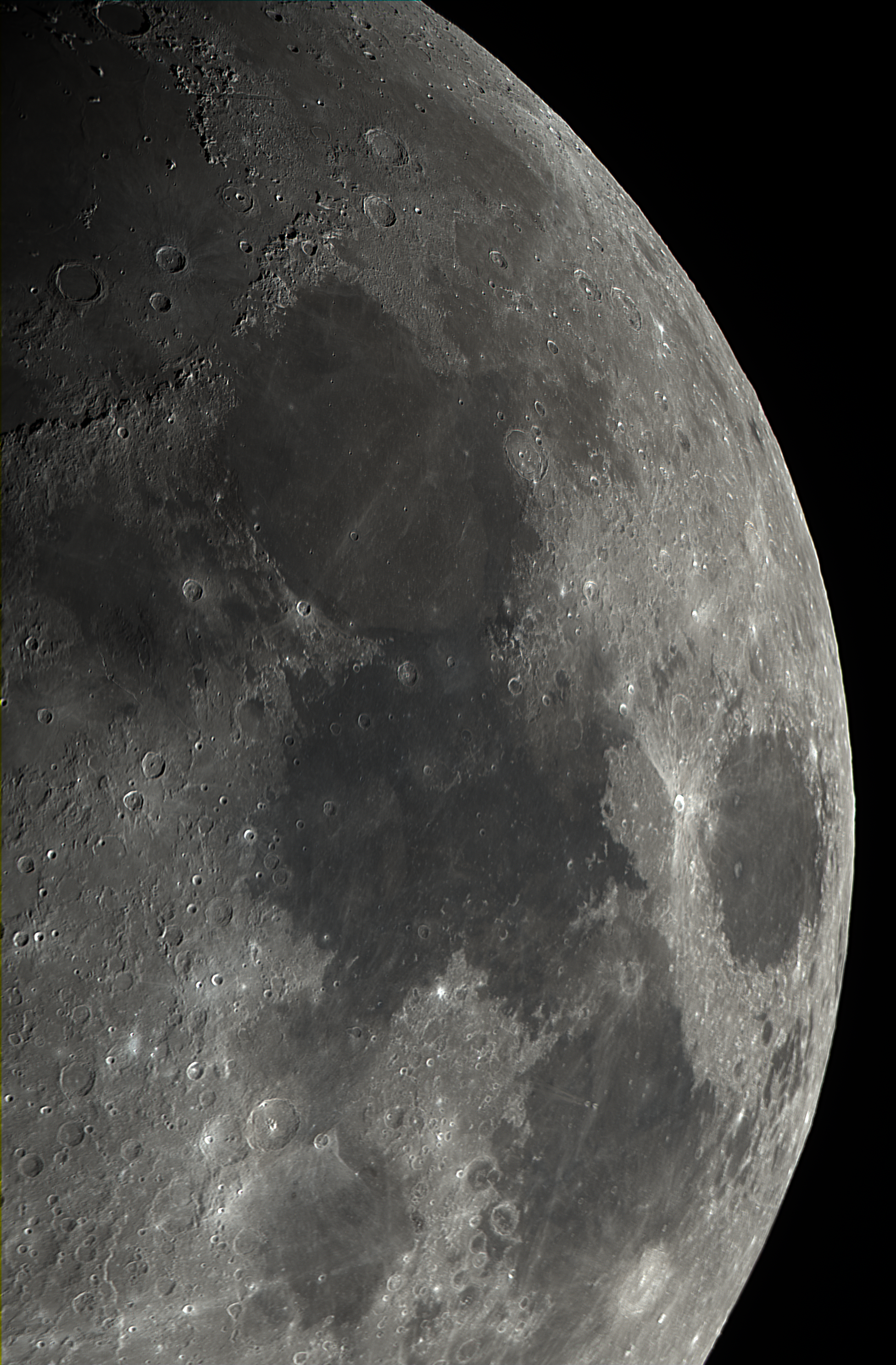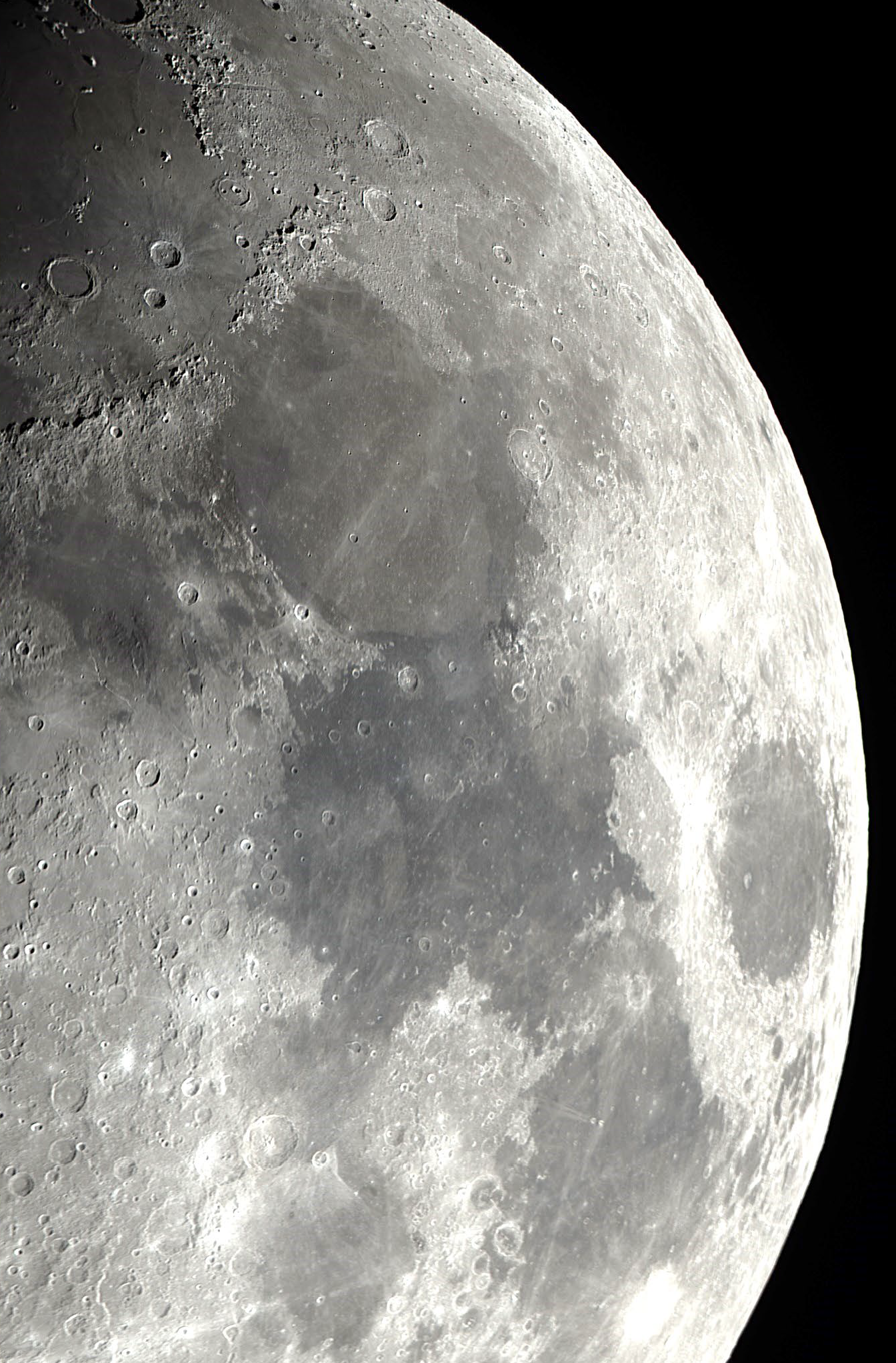Backyard lunar mineral prospection, Part II: Measuring titanium in Mare Tranquillitatis
2023 June 7
In Part I, we attempted to correlate the albedo and tonal differences of the lunar surface with compositional differences found by sample-return missions – principally the Apollo Moon landings and the Soviet Luna automated probes – and remote sensing from lunar orbit. We found that a wide range of compositional differences can be identified, particularly in lunar maria basalts, by using techniques of colour enhancement of RGB CCD images obtained with typical amateur telescopes and instruments. In particular, titanium-rich lunar basalts can be identified by their extremely dark colour and navy-blue tone. In contrast, iron-rich and aluminium-rich basalts show brown and orange colours respectively, with aluminium-rich highland regions a lighter tan colour. Colour-enhanced images of some lunar maria, particularly Mare Imbrium, show a wide range of tonalities, indicating considerable local variations of composition. Here, we extend this technique by showing that displaying inverse colour is a particularly powerful method for identifying the titanium abundance on the lunar surface. We find that titanium abundances in Mare Tranquillitatis determined using a 25cm telescope and CCD camera agree well with those found by remote sensing with the Lunar Reconnaissance Orbiter Camera (LROC).
Introduction
Although the Moon appears to be colourless, the existence of significant albedo variations is obvious even to the naked eye, with darker areas (known for several decades to be basaltic lava plains) and bright areas (highlands). These mare basalts cover ~17% of the lunar surface,1 mainly on the Earth-facing side of the Moon. It has been known also for more than a century that some areas do show hints of colour, with the warm yellow of Wood’s Spot, close to Aristarchus, being one of the best known and most obvious examples. Similarly, even in the pre-Apollo era, it was known from ultraviolet telescopic imaging that both red and blue maria existed, the former appearing unusually dark in UV photographic images of the lunar surface.
These colour differences influenced Apollo landing strategy, with Apollo 11 being targeted at a blue area and Apollo 12 at a red one. The main back-up landing site for Apollo 11, in Sinus Medii, was also a blue plain. The aim was to ensure that the first two missions would arrive in areas that were, apart from being flat and safe landing sites, carefully chosen on mineralogical grounds and assumed, correctly, to be of widely differing composition.
Although most of the colour images sent back from the lunar surface are a uniform grey – with the almost total absence of any colour save that of the astronauts and their equipment – there are also many images, taken both on the lunar surface and from orbit, that do show a brown or tan tonality. This brown colouration was noted in the early lunar flights, both by Neil Armstrong on the surface and by different crews observing from orbit. The perceived colour of the surface, grey or tan, was found to be dependent on the direction of observation relative to the position of the Sun (for more details, see Paper I).2
Ground truth, from an increasing range of sample return sites, has shown that considerable variations exist in the composition of the lunar soil and rocks, both between sites and even in the different areas sampled by a single mission. This was especially true after the Lunar Rover extended the range from which samples could be returned, allowing sites of particular geological interest, even several kilometres from the landing site, to be reached comfortably. The most extraordinary example of this is the Apollo 17 samples, with aluminium abundances that range from 6.5–21.5%,3 titanium abundances from 1.2–10.4%,4 and iron abundances from 8–22.5%.5,6 However, in the case of that mission, the presence of a trained geologist (Jack Schmitt) contributed to maximise the range of samples that were obtained from a landing site known (and selected) to be a geologically rich and highly varied region.
Overall, the different sample-return missions show several consistent patterns:
– There is a strong anti-correlation between the amount of aluminium and the amount of iron in samples: samples that are rich in iron are poor in aluminium and vice versa.
– Highland rocks are aluminium rich, but iron and titanium poor.
– In general, samples poor in aluminium have a high abundance of titanium, but there is a wide variation, from very high-titanium through to relatively low-titanium (although still high compared to Earth) basalts in the aluminium-poor samples.
As a consequence of the sample-return missions, we know that the composition and minerology of different areas of the lunar surface vary widely. With an increasing emphasis on the potential for future crewed flights to exploit the lunar resources in order to be self-sustaining, and with the rapidly increasing proximity of the long-awaited return to the Moon, there is considerable interest in detailed mineralogical mapping of the lunar surface.
These compositional differences from place to place in turn lead to slight colour differences that can be detected either spectroscopically, for example by the Moon Mineralogy Mapper (M3) experiment on the Indian Chandrayaan-1 lunar orbiter,7 or even telescopically by colour imaging. M³ was designed to obtain visible to near-infrared (420–3,000nm) reflectance data in 85 or 260 spectral bands, taking advantage, in particular, of the absorption features of different minerals in the near-infrared to analyse the surface composition.8 In contrast, ground-based imaging, which cannot take advantage of these infrared features, must rely on the more subtle colour variations in the visible, which can be detected by colour enhancement techniques of RGB CCD imaging, as shown in Part I.
A second, fundamental reason why colour and albedo variations exist on the lunar surface is weathering.9 Cosmic radiation darkens and weathers surface materials, while impacts penetrate the weathered layer, exposing brighter, unweathered material from the subsurface. This latter process manifests itself as bright, fresh craters, some of which are also the centre of bright rays crossing the lunar disc. Similarly, secondary impacts may have resurfaced a significant fraction of the terrain around a fresh crater, gardening the surface and exposing a more extended region of unweathered material.
The only Apollo mission that explored a region of ray material was Apollo 12, which landed within, or close to, one of the rays of the crater Kepler, leading to an estimate that the surface skin of weathered material may be as much as 2m deep.10
In Part I, we found that a wide range of compositional differences in lunar maria basalts can be identified by using techniques of colour enhancement. In particular, titanium-rich basalts can be identified easily by their extremely dark colour and navy-blue tone, while iron-rich and aluminium-rich basalts show brown and orange colours, respectively. Colour-enhanced images of some lunar maria show a range of shades and tonalities. This is particularly evident in Mare Imbrium, with its wide variety of compositional units, as established by M3,8 with colours ranging from russet to blue when observed in colour-enhanced images.


Observations
The telescopic images presented in this paper were obtained by JJGC, with a 25cm reflector, applying the technique of video capture. The camera used was an ASI 178MM (mono) astronomical imaging CCD, manufactured by ZWO, with a CMOS detector using CMOS-optimised 1.25-inch Baader Planetarium RGB filters.11 The filter passbands are 595–690nm, 490–580nm and 400–510nm respectively, for R, G & B.
For the images presented here, a total of 640 seconds of video were obtained in each channel, at 18 frames per second, on a night of generally good seeing. This gave a total of 8,640 frames in each band. Of these, the best 500 were selected for combination into the final master image in each band. Where, as in Part I, images are composed of multiple overlapping tessellae, the same method of capture is applied for each tessella.
The individual image sequences were then composed into the final video, using the ASICap software of the camera manufacturer. This video was processed using PIPP software (see the online tutorial for details),12 to obtain the final image for each tessella. Where required, the tessellae were mosaicked together into a combined image using Astrosurface and Fitswork free software. Finally, colour intensification was carried out using the GIMP freeware, a widely used and well-known image processing package.
Within this process, the most delicate and sensitive part is the colour combination. The different colour frames must be aligned at the pixel level, which is the most difficult and time-consuming part of the image processing: it is essential that this part be done as accurately as possible to ensure the quality and reliability of the final result. This process of alignment may need to be repeated several times (as was the case for the final image shown as Figure 3) before a fully satisfactory result is achieved.
(Log in to view the full illustrated article in PDF format)
| The British Astronomical Association supports amateur astronomers around the UK and the rest of the world. Find out more about the BAA or join us. |
